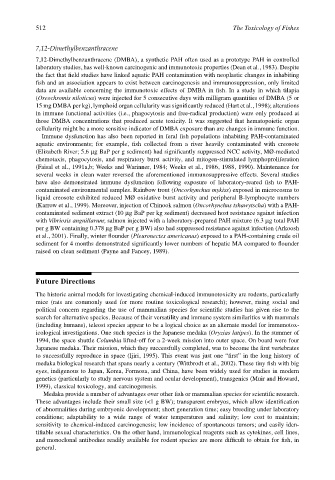Page 532 - The Toxicology of Fishes
P. 532
512 The Toxicology of Fishes
7,12-Dimethylbenzanthracene
7,12-Dimethylbenzanthracene (DMBA), a synthetic PAH often used as a prototype PAH in controlled
laboratory studies, has well-known carcinogenic and immunotoxic properties (Dean et al., 1983). Despite
the fact that field studies have linked aquatic PAH contamination with neoplastic changes in inhabiting
fish and an association appears to exist between carcinogenesis and immunosuppression, only limited
data are available concerning the immunotoxic effects of DMBA in fish. In a study in which tilapia
(Oreochromis niloticus) were injected for 5 consecutive days with milligram quantities of DMBA (5 or
15 mg DMBA per kg), lymphoid organ cellularity was significantly reduced (Hart et al., 1998); alterations
in immune functional activities (i.e., phagocytosis and free-radical production) were only produced at
those DMBA concentrations that produced acute toxicity. It was suggested that hematopoietic organ
cellularity might be a more sensitive indicator of DMBA exposure than are changes in immune function.
Immune dysfunction has also been reported in feral fish populations inhabiting PAH-contaminated
aquatic environments; for example, fish collected from a river heavily contaminated with creosote
(Elizabeth River; 5.6 µg BaP per g sediment) had significantly suppressed NCC activity, MØ-mediated
chemotaxis, phagocytosis, and respiratory burst activity, and mitogen-stimulated lymphoproliferation
(Faisal et al., 1991a,b; Weeks and Warinner, 1984; Weeks et al., 1986, 1988, 1990). Maintenance for
several weeks in clean water reversed the aforementioned immunosuppressive effects. Several studies
have also demonstrated immune dysfunction following exposure of laboratory-reared fish to PAH-
contaminated environmental samples. Rainbow trout (Oncorhynchus mykiss) exposed in microcosms to
liquid creosote exhibited reduced MØ oxidative burst activity and peripheral B-lymphocyte numbers
(Karrow et al., 1999). Moreover, injection of Chinook salmon (Oncorhynchus tshawytscha) with a PAH-
contaminated sediment extract (10 µg BaP per kg sediment) decreased host resistance against infection
with Vibriosis anguillarum; salmon injected with a laboratory-prepared PAH mixture (6.3 µg total PAH
per g BW containing 0.378 µg BaP per g BW) also had suppressed resistance against infection (Arkoosh
et al., 2001). Finally, winter flounder (Pleuronectes americanus) exposed to a PAH-containing crude oil
sediment for 4 months demonstrated significantly lower numbers of hepatic MA compared to flounder
raised on clean sediment (Payne and Fancey, 1989).
Future Directions
The historic animal models for investigating chemical-induced immunotoxicity are rodents, particularly
mice (rats are commonly used for more routine toxicological research); however, rising social and
political concern regarding the use of mammalian species for scientific studies has given rise to the
search for alternative species. Because of their versatility and immune system similarities with mammals
(including humans), teleost species appear to be a logical choice as an alternate model for immunotox-
icological investigations. One such species is the Japanese medaka (Oryzias latipes). In the summer of
1994, the space shuttle Columbia lifted-off for a 2-week mission into outer space. On board were four
Japanese medaka. Their mission, which they successfully completed, was to become the first vertebrates
to successfully reproduce in space (Ijiri, 1995). This event was just one “first” in the long history of
medaka biological research that spans nearly a century (Wittbrodt et al., 2002). These tiny fish with big
eyes, indigenous to Japan, Korea, Formosa, and China, have been widely used for studies in modern
genetics (particularly to study nervous system and ocular development), transgenics (Muir and Howard,
1999), classical toxicology, and carcinogenesis.
Medaka provide a number of advantages over other fish or mammalian species for scientific research.
These advantages include their small size (<1 g BW); transparent embryos, which allow identification
of abnormalities during embryonic development; short generation time; easy breeding under laboratory
conditions; adaptability to a wide range of water temperatures and salinity; low cost to maintain;
sensitivity to chemical-induced carcinogenesis; low incidence of spontaneous tumors; and easily iden-
tifiable sexual characteristics. On the other hand, immunological reagents such as cytokines, cell lines,
and monoclonal antibodies readily available for rodent species are more difficult to obtain for fish, in
general.

